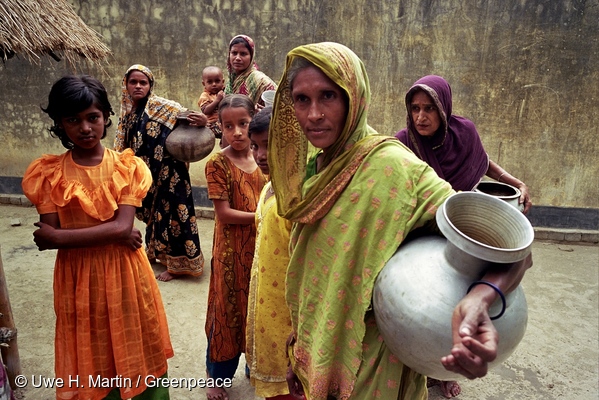Waking up before dawn every day, Asma Khatun walks to a water plant five kilometres away to collect fresh drinking water for her 11-member family. It will be midday or even later before she returns home to her village in southwest Bangladesh’s Satkhira district, where all freshwater sources were destroyed after the devastating Cyclone Aila in 2009.
Without the 10-kilometre trek through an uneven path to the plant near Ramjannagor Dighi where the pond water is treated, there will be no water for cooking and drinking. Though the walk itself takes two hours, the 25-year-old says she has to queue up for much of the day to get her turn at the tap.
“We need around two hours to reach the water plant. When we reach there, we have to wait in line for hours to collect water,” Asma said.
Six years after Cyclone Aila killed at least 200 people in Bangladesh and neighbouring West Bengal in India, other households in Satkhira as well as those in the other coastal districts of Khulna and Bagerhat are suffering just as Asma’s family. The drinking water crisis has hit them all.
Lipi Akhter of Shura-6 under Shyamnagar Upazila who lives close to Asma says bitterly that the cyclone snatched everything away from them and damaged all their sweet water sources.
“Now we must go out of home early in the morning to collect water and return home at noon as the water in our village ponds is not suitable to drinking. It has become too saline,” she said.
Life, as they knew it, changed forever after that May day in 2009 when the cyclone hit. The very fabric of family life has been stretched with women out most of the day to collect water while the men are at work.
Problems of salinity
Cyclone Aila damaged most water infrastructure and contaminated all sources of surface water in southwestern Bangladesh. In most places, tube-wells don’t work because of salinity in the shallow and deep aquifer levels, leaving most people dependent on surface water for drinking and cooking.
Despite the passage of six years, the government is yet to restore freshwater sources in the country’s coastal belt. This is primarily because of lack of water flow in rivers, which contributes to the rise of salinity.
“Bangladesh is an active delta. About 1.5 million tonnes of silt flows through the country’s rivers each year filling up riverbeds, which creates obstacle to the flow of the rivers,” explained Zafar Ahmed Khan, secretary of the water resources ministry.
Holding out some hope of things improving, he said the government had taken various steps to resolve water problems in the coastal region. Once the proposed Ganga Barrage Project is built and the dredging of the Gorai river is complete, the flow of river water will increase in the coastal region, thereby cutting salinity problems. “And freshwater sources will be restored. Eventually, the salinity problem will be resolved…,” Khan said.
Women at high risk
The lack of clean water has led to rise in water-borne diseases like typhoid, cholera and diarrhoea in the coastal region. Children and women are particularly vulnerable.
According to a 2012 government study, 61% of the coastal region’s population faces serious health issues. Two years before that, a 2010 study found that most coastal inhabitants suffer from skin diseases as well as diarrhoea and dysentery. Alarmingly, 76% of children were affected.
With not enough water, women and young girls are amongst the worst sufferers. And given the taboo related to menstruation in deeply conservative rural Bangladesh, they are silent too. “Women have to deal with severe itching, soreness and infections because of the unhygienic conditions brought on by the lack of clean water,’ Josna Akter, a community health worker who is working in Ramjannagor Union, told thethirdpole.net.
In Akter’s estimate, four in every 10 adolescent girls in the coastal districts are affected.
The poor reproductive health has led to irregular menstrual cycles, low birth weight babies and physically challenged children because women are denied the simple necessities of hygienic surroundings and clean water, said Syed Monibul Hasan, project manager of the NGO Shushilan.
Stressing the need for awareness programmes, local healthcare practitioner Abdul Majid said ignorance and illiteracy are exacerbating factors.
As coastal women drink less water, high blood pressure, heart diseases and kidney diseases are common place too.
“I have hypertension. But it’s not just me. Many other women in our village suffer from the same problem because we are forced to drink saline water,” said 36-year-old Lipi Akhter who spends nearly Tk 350 (US$5) each month on medicines.
Disappearing safe water zones
The coastal population of Bangladesh will become more vulnerable to salinity intrusion in a changing climate. A World Bank report said in February 2015 that climate change is likely to increase river salinity leading to shortages of drinking water and irrigation and significant changes in aquatic ecosystems in the southwest coastal areas during the dry season by 2050.
The increase in soil salinity may lead to rice yield declining by 15.6%, thereby significantly reducing farmer income.
Despite this – and the high incidence of disease – most people in the region are unaware of the increasing salinity and its many implications. According to a new study carried by the Department of Public Health Engineering (DPHE) and the Institute of Water Modelling, 84% of people don’t know about salinity in groundwater in the country’s coastal region.
The study was carried out over a 1,534 square kilometre area in parts of Khulna, Jessore and Satkhira during 2010-2014 to assess the extent of salinity and intrusion, and aquifer vulnerability in the area.
It predicts that the freshwater zone area (with salinity less than 1000 ppm) will decrease. Within the saline zone, areas under severe salinity will increase by 14% by 2050, accelerating the freshwater crisis in the region.
“Salinity has been increasing in the coastal aquifer due to sea level rise caused by global climate change, but the people of the coastal region are not aware of the presence of salinity in groundwater as they have become used to salinity,” principal investigator of the study M. Rezaul Hasan told thetheirdpole.net.
He added that the aquifer saline zone will increase by 2.27% by 2050 while fres water zone will decrease by 3.44%.
Given the fact that the government has yet to address the damages wrought by Cyclone Aila, this is bad news indeed for women like Asma Khatun and Lipi Akhter. And for many thousands like them.

